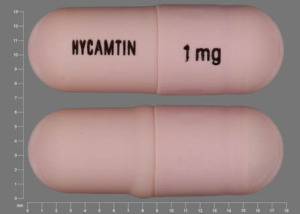Topotecan Disease Interactions
There are 6 disease interactions with topotecan.
Antineoplastics (applies to topotecan) infections
Major Potential Hazard, High plausibility. Applicable conditions: Infection - Bacterial/Fungal/Protozoal/Viral
Because of their cytotoxic effects on rapidly proliferating tissues, antineoplastic agents frequently can, to varying extent, induce myelosuppression. The use of these drugs may be contraindicated in patients with known infectious diseases. All patients should be instructed to immediately report any signs or symptoms suggesting infection such as fever, sore throat, or local infection during antineoplastic therapy. Close clinical monitoring of hematopoietic function is recommended.
Topotecan (applies to topotecan) bleeding disorders
Major Potential Hazard, High plausibility.
Topotecan induces myelosuppression. Severe thrombocytopenia (< 25,000/mm3) has been reported during topotecan therapy. Patients should be instructed to immediately report any signs or symptoms suggesting bleeding such as petechiae, purpura, hematuria, or melena. Close clinical monitoring of hematopoietic function is recommended. Therapy with topotecan should not be initiated in patients with platelet counts < 100,000/mm3. Subsequent courses of topotecan should be withheld until platelet counts exceed 100,000/mm3.
Topotecan (applies to topotecan) myelosuppression
Major Potential Hazard, High plausibility. Applicable conditions: Bone Marrow Depression/Low Blood Counts, Fever
Topotecan induces myelosuppression. Severe neutropenia (< 500/mm3), severe thrombocytopenia (< 25,000/mm3), and severe anemia (< 8 g/dl) have been reported frequently. Patients should be instructed to immediately report any signs or symptoms suggesting bone marrow suppression such as fever, sore throat, local infection, or bleeding. Close clinical monitoring of hematopoietic function is recommended. Therapy with topotecan should not be initiated in patients with neutrophil counts < 1500/mm3 and/or platelet counts < 100,000/mm3. Subsequent courses of topotecan should be withheld until neutrophil counts exceed 1000/mm3, platelet counts exceed 100,000/mm3, and/or hemoglobin levels are at least 9 g/dl.
Topotecan (applies to topotecan) renal dysfunction
Major Potential Hazard, High plausibility.
Topotecan is partially eliminated by the kidney. Approximately 30% of topotecan is excreted in the urine. Plasma clearance of topotecan was reduced 33% in patients with mild renal impairment (creatinine clearance of 40 to 60 mL/min) and 66% in patients with moderate renal impairment (creatinine clearance of 20 to 40 mL/min). Therapy with topotecan should be administered cautiously and at a reduced dosage in patients with moderate to severe renal dysfunction.
Topotecan (applies to topotecan) diarrhea
Moderate Potential Hazard, Moderate plausibility.
Topotecan capsules can cause severe and life-threatening diarrhea that may require hospitalization. It is recommended to withhold treatment for severe diarrhea. Manage diarrhea caused by topotecan aggressively and do no administer topotecan capsules to patients with Grade 3 or 4 diarrhea. Reduce the dose of therapy after recovery to Grade 1 or less. Close monitoring is recommended.
Topotecan (applies to topotecan) interstitial lung disease
Moderate Potential Hazard, Moderate plausibility. Applicable conditions: Pulmonary Impairment
Fatal cases of interstitial lung disease (ILD) have occurred with the use of topotecan. Risk factors include a history of ILD, pulmonary fibrosis, lung cancer, thoracic radiation, and use of pneumotoxic drugs and/or colony stimulating factors. It is recommended to monitor patients for pulmonary symptoms indicative of ILD and permanently discontinue treatment for confirmed ILD.
Switch to professional interaction data
Topotecan drug interactions
There are 431 drug interactions with topotecan.
Topotecan alcohol/food interactions
There is 1 alcohol/food interaction with topotecan.
More about topotecan
- topotecan consumer information
- Check interactions
- Compare alternatives
- Pricing & coupons
- Reviews (1)
- Latest FDA alerts (1)
- Side effects
- Dosage information
- During pregnancy
- Drug class: miscellaneous antineoplastics
- Breastfeeding
- En español
Related treatment guides
Drug Interaction Classification
| Highly clinically significant. Avoid combinations; the risk of the interaction outweighs the benefit. | |
| Moderately clinically significant. Usually avoid combinations; use it only under special circumstances. | |
| Minimally clinically significant. Minimize risk; assess risk and consider an alternative drug, take steps to circumvent the interaction risk and/or institute a monitoring plan. | |
| No interaction information available. |
See also:
Further information
Always consult your healthcare provider to ensure the information displayed on this page applies to your personal circumstances.


